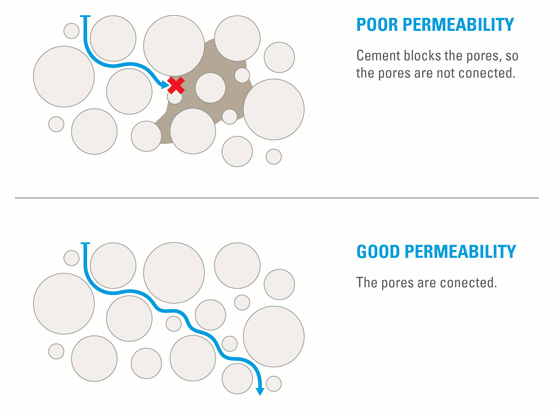Understanding porosity and permeability
How much water moves underground and how fast it moves depends on a number of factors. Two important factors are the porosity and permeability of the rocks.
Porosity
Rocks are made up of grains or crystals that fit together. In cases where the fit is very tight and there are no gaps or pore spaces between the grains or crystals, we say that this rock has no porosity. At the other end of the scale, some rocks have lots of pore space between grains and so there is room for air, water or other liquids and gases.

In the top diagram, where there is any material (or cement) in the rock to fill in the gaps holding the grains together, there will be less pore space. The bottom diagram shows that the more space between the grains, the greater the porosity.
The porosity of a rock varies because of the size of the grains in the rock and the shape of the grains. Another factor that affects the porosity of a rock is whether or not there is any material in the rock (or cement) to fill in the gaps between pore spaces and hold the grains together. If a rock has a lot of gaps between grains it is said to have good porosity and a lot of water can fit between the grains. A rock with good porosity can hold a lot of groundwater.
Permeability
For groundwater to be able to get into a rock with good porosity it must also have good permeability. For a rock to be permeable and for water to move through it, the pore spaces between the grains in the rock must be connected. Permeability is therefore a measure of the ability of water to move through a rock.

In the top diagram, even though there is good porosity, there is material (or cement) in the rock to fill in the gaps blocking the pore space between the grains so the water at the bottom cannot flow to the top – the pores are not connected. In the diagram on the bottom, there is nothing to stop the flow of water – the pores are all connected.
Page last updated: 02 Jun 2021